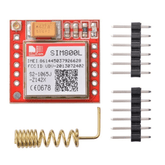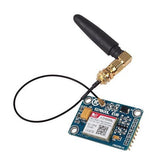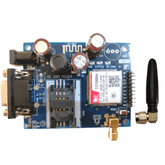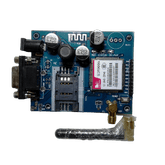Why GSM Modules Are Essential for IoT Projects
Summary
In the world of telecommunications, GSM (Global System for Mobile Communications) and GPRS (General Packet Radio Service) are essential technologies for mobile communication.
This blog introduces GSM modules, their types, and their functions. It also highlights where GSM is used and why it's important.
Additionally, it answers common questions such as whether GSM modules need a SIM and whether GSM is the same as WiFi. With this information, readers can better understand the basics of GSM and its role in modern communication.
What is GSM:
GSM, also known as Global System for Mobile Communications, serves as a digital cellular technology utilized for mobile communication. It stands out as the most commonly employed mobile communication system globally, with more than 80% of all mobile phones leveraging GSM technology.
What is GPRS:
General Packet Radio Service, commonly known as GPRS, is a wireless communication service that operates on the GSM network and uses packet switching technology.
By enabling quicker transfer rates of data, GPRS facilitates various data-intensive activities such as browsing the internet, sending emails, and performing other similar tasks using mobile phones.
Intro to GSM Module
A GSM module refers to a compact electronic apparatus that can be incorporated into various devices to offer GSM and GPRS functionalities.
These modules find use in diverse applications, such as wireless data transfer, remote monitoring, and machine-to-machine (M2M) communication.
The SIM800L is a tiny cellular module that supports GPRS transmission, SMS sending and receiving, and voice calls making and receiving.
This module is the ideal choice for any project that needs long-distance connectivity because of its low cost, compact size, support for four bands of frequencies, and low cost.
The power module starts up after being connected, looks for a cellular network, and logs in automatically. LEDs on the board show the connection state (no network coverage - fast blinking, logged in - slow blinking).

Where is GSM used?
GSM, or Global System for Mobile Communications, is a digital cellular technology used for mobile communication.
GSM technology serves as the primary means of making and receiving phone calls, sending and receiving text messages on mobile phones, and accessing the internet and other data networks for email, social media, and other online services.
Furthermore, GSM enables machine-to-machine (M2M) communication, facilitating data exchange and communication between devices without human involvement.
It is a prevalent technology utilized in numerous countries globally and remains an essential tool for maintaining connectivity between people and businesses.
Types of GSM modules?
There are several types of GSM modules available, including:
Miniaturized GSM modules:
These are small, compact versions of GSM modules designed for use in portable electronic devices, such as cell phones, tablets, and GPS devices.
Quad-band GSM modules:
These modules operate on four frequency bands (850 MHz, 900 MHz, 1800 MHz, and 1900 MHz) and are compatible with most global GSM networks.
Dual-band GSM modules:
These modules operate on two frequency bands (900 MHz and 1800 MHz) and are typically used in regions where these bands are used for GSM communication.
Industrial GSM modules:
These modules are designed for use in industrial and commercial applications and are typically larger and more rugged than consumer-grade GSM modules.
GSM/GPRS modules:
These modules include both GSM and GPRS (General Packet Radio Service) capabilities, allowing for faster data transfer rates and the ability to connect to the internet and other data networks.
GSM/GPS modules:
These modules include both GSM and GPS capabilities, allowing for location tracking and other location-based services.
3G/4G GSM modules:
These modules support 3G or 4G cellular network technology in addition to GSM, which means they can access faster internet speeds and more advanced features.
SIMCOM GSM modules:
These modules are developed by SIMCOM company and are widely used in different applications such as tracking, remote monitoring and M2M communication.
Functions
The main functions of a GSM module include:
- Making and receiving phone calls.
- Sending and receiving text messages.
- Connecting to the internet and other data networks.
- Location tracking.
- Remote monitoring.
- Machine-to-machine (M2M) communication.
Why is GSM important?
The significance of GSM can be summarized as follows:
- Reliability and wide availability: GSM provide a reliable and widely-available mobile communication solution, which allows individuals and businesses to stay connected and communicate with each other, regardless of their location.
- Global standard: GSM is a global standard for mobile communication, which means that GSM-enabled devices can be used in many countries around the world.
- Data and internet connectivity: GSM allows for data transfer and internet connectivity through GPRS and EDGE, which enables users to access email, social media, and other online services on their mobile devices.
- M2M communication: GSM technology enables machine-to-machine (M2M) communication, which allows devices to communicate and share data with each other without human intervention.
- Cost-efficient: GSM technology is cost-efficient as it allows for low-cost calls and text messages due to its digital nature.
- Location tracking: GSM modules with GPS capabilities allow for location tracking and other location-based services.
Overall, GSM plays a crucial role in keeping people and businesses connected and enables various services and applications, making it a significant technology in the field of mobile communication.
Does the GSM module need SIM?
A GSM module does require a SIM card in order to function. SIM stands for Subscriber Identity Module and it holds the subscriber's information, like the phone number, the service provider, and other details.
Although the GSM module can function limitedly using the AT commands, but its complete functionality is observed only with the help of SIM card.
Is GSM the same as WiFi?
Although both technologies transmit data via radio waves, GSM and WiFi are distinct from each other. GSM is a mobile communication technology that supports mobile phone and data networks, while WiFi is a wireless networking technology that enables local area networks (LANs) and internet access. Moreover, they operate on different frequencies and possess dissimilar capabilities.
Conclusion:
GSM module is a small electronic device used to provide GSM and GPRS capabilities to other devices. It's widely used around the world, and has many use cases ranging from remote monitoring to M2M communication. GSM is important because it provides a reliable and widely-available mobile communication solution. While GSM module and WiFi are different things, they both play crucial roles in keeping us connected.
If you appreciate our work don't forget to share this post and leave your opinion in the comment box.
Please do check out other blog posts about Popular Electronics and Do check out Interfacing GSM Module with Arduino
Make sure you check out our wide range of products and collections (we offer some exciting deals!)










